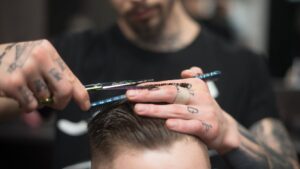
Unleashing a wild yet stylish vibe, the “wolf cut” has roared its way into the hairstyle scene. This hybrid hairdo, a blend of the ’70s shag and ’80s mullet, is the latest trend captivating folks eager to make a bold statement. It’s a cut that’s defying norms, breaking boundaries, and setting a new standard in the world of fashion.
Curtain Bangs:gexbwva9ars= Wolf Cut

Thriving as a bold, trendy hairstyle, the wolf cut is a daring blend of iconic hairstyles from past eras. It merges elements of 70s shag cuts with elements of 80s mullet cuts, forming a unique, versatile look that has gained considerable notice among today’s style influencers.
The wolf cut, noted for its fiery uniqueness, began headlining fashion trends in South Korea and quickly swept through other regions, including Europe and the United States. It’s celebrated as more than a simple hairstyle. It’s a full-blown trend that has seen significant uptake among renowned celebrities, everyday individuals, and social media influencers. Everyone from pop stars to fashion-forward individuals has adopted this bold, exciting style, hence its rampant spread and high popularity.
The Rise of the Wolf Part in Fashion
Celebrity Influence

Amid Hollywood’s elite, it’s an unmistakable trend. Stars like Miley Cyrus and Billie Eilish have short-lived their traditional, typically polished tresses for the untamed wolf cut. Their influence amplifies its appeal, encouraging fans and admirers alike to embrace this wild and bold look.
A-listers from different realms – musicians, actors, models – contribute to the rise of the wolf cut, further cementing it as a prominent feature in universal fashion.
Social Media and Viral Trends
Social media fuels the wolf cut’s ascent in the digital space. Video sharing platforms, including TikTok, spotlight the trend, as users share their own wolf cut transformations and experiences. Viral hashtags (#wolfcut or #wolfcutchallenge) on TikTok and Instagram support the spread of the cut among users of varying ages and backgrounds.
The innate shareability and engagement potential on these platforms grants the wolf cut a steady rise in the fashion scene, affirming its power as a style that breaks and defines new norms.
How to Style a Wolf Cut
For Different Hair Types

From fine to coarse, straight to curly, the wolf cut accommodates a range of hair types. If the hair is straight and fine, creating volume at the top, possibly using hair mousse or a fine-tooth comb might be ideal. For wavy hair, air or diffuser drying and incorporating more layers provides better texture, showcasing the cut’s versatility.
Meanwhile, with curly and coily hair, avoiding heavy products that weigh it down should be the goal; instead, water-based or light products may help define the curls showcasing the wild ethos of this haircut.
Maintenance and Care Tips
Good style begins with healthy hair. Regular trims, approximately every six to eight weeks, multiply the longevity of the wolf cut, while ensuring it retains its unique shape and structure. Maintaining moisture balance is crucial, particularly for curly or colored hair, which can gain from deep conditioning treatments or sulfate-free shampoos.
Additionally, heat styling should ideally be minimal, as it can dehydrate the hair, causing it to appear lackluster. When it comes to product usage, less is usually more, as adding excessive amounts might overwhelm the hair, turning the ‘wolf’ into a ‘sheep’. Overall, prioritizing hair health fosters a vibrant, majestic wolf cut that truly stands out.
Taking the Fashion World by Storm
The “wolf cut” hairstyle has undoubtedly made its mark on the global fashion scene. With its roots in South Korea, it’s been adopted by celebrities and influencers alike, making it a go-to choice for those seeking an edgy, versatile look.
Social media platforms have fueled its popularity, with TikTok leading the charge. This hairstyle’s adaptability to various face shapes and its long-lasting trend appeal are clear advantages. However, it’s essential to consider the potential downsides, such as regular upkeep, possible unsuitability for thin hair, and conflicts with certain workplace dress codes.
